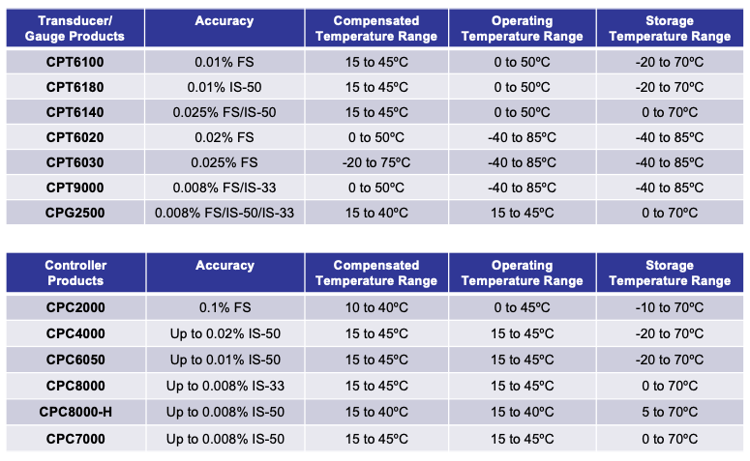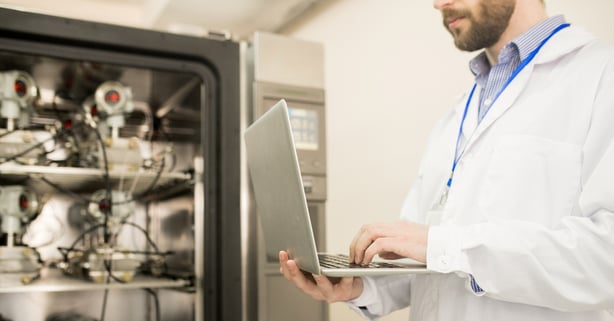What does it mean when a manufacturer refers to "temperature compensation" in the specifications of pressure products?
As temperature and pressure typically go hand-in-hand, most modern pressure devices will have a number of temperature specifications throughout their datasheet or operating instructions. These can get confusing, because each of these temperature specifications affect the device’s functionality in a different way. The three most common specs that accompany high accuracy, pressure calibration devices are storage temperature range, operating temperature range and compensated temperature range.
Storage Temperature Range and Operating Temperature Range
Storage temperature and operating temperature are quite easy to interpret given their nomenclature. The storage temperature range of a pressure device defines the limits at which the instrument could begin to deteriorate. This can be in the form of electrical component damage, assembly breakdowns like adhesive limitations, or even failures within the sensing element itself.
Although, operating temperature range is sometimes equivalent to the storage temperature, many times these values will differ. It is very important to check this range on the datasheet, as it is possible to cause damage if the instrument is powered on while outside of its operating temperature limits. The minimum and maximum operating range limits correspond to the limits of the most temperature sensitive internal components operate per their individual ratings.
Compensated Temperature Range
Perhaps one of the more ambiguous specifications within pressure monitoring devices is the compensated temperature range, sometimes referred to as calibrated temperature range or, more simply, temperature range. Generally speaking, and especially for high accuracy calibration tools, this is the most important temperature specification that is provided with your pressure device. Many lower accuracy, process tools will have an independent breakdown of media temperature, environmental temperature, as well as compensated temperature ranges. These are often accompanied with an additional error per degree Celsius because of the harsh environments they can be used in. For the purpose of this blog, we will focus on high-end, precision measuring instruments (<0.05% FS).
 Example of Temperature Specifications for Mensor Products
Example of Temperature Specifications for Mensor Products
Most precision pressure transducers go through a temperature characterization process in order to develop the compensated temperature range parameters. This process involves putting the transducer in a chamber, stabilizing the chamber/transducer temperature, then monitoring the transducer output throughout its pressure range. This process is done at multiple temperature points throughout the compensated temperature range. Once the transducer has gone through this process, the output is adjusted to compensate for the different temperatures. By doing this, the accuracy of the transducer throughout its pressure range is the same for any temperature within the compensated temperature range.

Factors Affecting Temperature Compensation
Now that the temperature and pressure at the sensor have been examined, other external temperature effects should be considered, including the environment and the media temperatures.
First, let’s consider pressure controllers. With pneumatic and hydraulic pressure controllers, the compensated temperature range will primarily depend on the environment and, more specifically, the temperature inside the controller chassis. This is often true even if the measure/control output is being plumbed to a controlled temperature oven or chamber. While the media temperature may be extremely hot or cold at the DUT and plumbing inside the temperature chamber, standard pressure tubing will allow the media to dissipate heat very quickly as it flows to and from the controller. Polyurethane or nylon tubing are very common for pressure applications when the temperatures are between -50 and 100 Celsius. Outside of these ranges, it’s often swapped for a more durable material like aluminum or stainless steel. With either of these materials, the media will typically reach room temperature well before the reference transducer, which is detecting the pressure. In these cases, it is important to make sure the room and controller environment are within the compensated temperature specification.
Alternatively, temperature compensation in stand-alone pressure transducers can be a little tricky. One of their biggest benefits is that they are much easier to move around or install near the desired measurement point or DUT, but this can also create more obstacles. If both the media and the environment are within the compensated temperature range, there will be no problems with the performance of the transducer, but when the media is outside that range, it can negatively affect the transducer performance. The sensor element and transducer hardware structure can begin to break down at these extreme temperatures. If the media must stay outside the transducer temperature range, one of the easiest solutions is to add a few feet tubing from the DUT to the transducer. This will allow the temperature dissipation to occur while still keeping the reference transducer relatively close to the DUT. Some transducers, like the CPT9000 and CPT6020, have a temperature output that can be queried in order to ensure the sensor is operating within the compensated temperature range.
Conclusion
From low accuracy process tools to the most premium pressure devices on the market, all are affected by temperature. In the process industry, the temperature parameters may be much larger but they will also be accompanied by an equivalent accuracy loss as the temperature changes to the more extreme ends. On the other hand, many highly accurate calibration devices, like the CPC6050 Modular Pressure Controller or CPT9000 Premium Pressure Transducer, will have a compensated temperature range that will allow the device to hold its accuracy through temperature changes. The next time you consider purchasing a pressure instrument, be sure to investigate the environment that the instrument will be used in order to maintain the highest accuracies possible.
Related Reading:
- Accuracy and Uncertainty in Performance Specifications
- What is Intelliscale Accuracy? | A Mensor Measurement Specification
- Clean, Dry Air: Pressure Media for Calibration Equipment Manufacturing
- Adaptive Control: How Pressure Controllers Adjust to Changing Conditions
- What Does K=2 Mean in Accuracy and Uncertainty Specifications?

